You'll need your solar-cooked meat to reach 165°F internal temperature to kill harmful bacteria that can cause serious foodborne illnesses. Between 40°F and 140°F, bacteria multiply rapidly in what's called the "danger zone," with colonies potentially doubling every 20 minutes. Common meat-dwelling bacteria like Salmonella and Staphylococcus can only be destroyed when the internal temperature hits and maintains 165°F for at least 15 minutes. Even though solar cooking is an eco-friendly method, it follows the same food safety rules as conventional cooking. Understanding proper temperature control can make your solar cooking both safe and successful.
Food Safety Temperature Basics
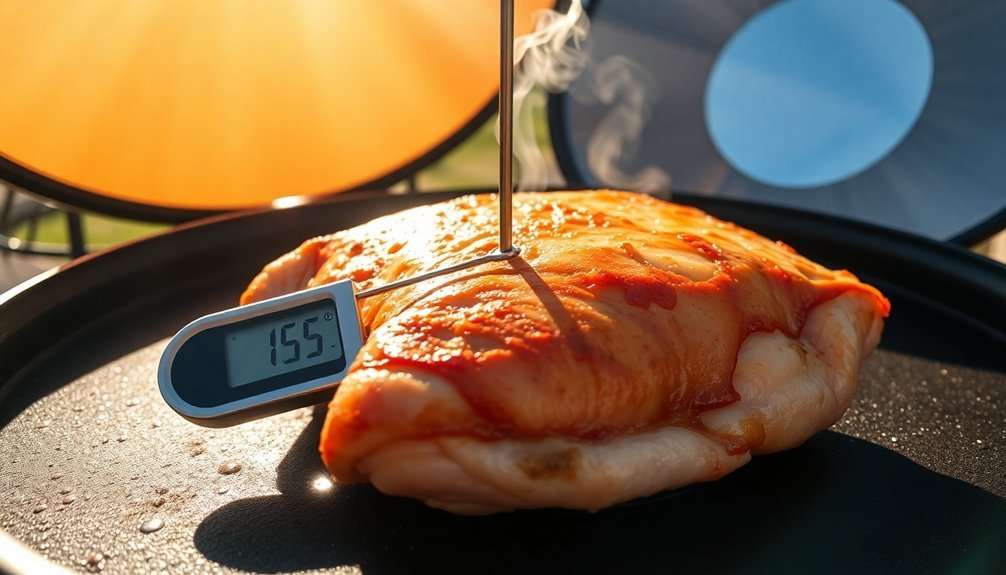
When it comes to food safety, understanding proper temperature control is your first line of defense against foodborne illness.
You'll need to remember that bacteria thrive in the "danger zone" between 40°F and 140°F, which means you must keep cold foods cold and hot foods hot.
For meats, you'll find different safe temperatures depending on the type. You must cook poultry and stuffed meats to 165°F, while ground meats need to reach 160°F.
Whole cuts of red meat can be served at 145°F. If you're serving eggs, they should hit 160°F for hot holding or 145°F for immediate service.
When you're reheating any food, especially leftovers, always bring it to 165°F to guarantee it's safe to eat. Ensuring food safety also means checking after resting since meat temperatures continue to rise after removing from heat.
Bacterial Growth in Meat
Since raw meat inherently harbors both harmful and spoilage bacteria, you'll need to understand how these microorganisms multiply to keep your food safe.
Bacteria thrive in temperatures between 50°F and 130°F, with ideal growth occurring around 95-100°F. At these temperatures, bacterial colonies can double every 20 minutes, leading to rapid contamination.
Your raw meat may contain several types of concerning bacteria:
- Salmonella and Staphylococcus, which commonly enter meat during slaughter
- Clostridium perfringens, whose spores survive normal cooking
- Pseudomonas species that cause spoilage but aren't typically harmful
While refrigeration slows bacterial growth, it doesn't stop it completely.
Some bacteria, called psychrotrophs, can still multiply at near-freezing temperatures. That's why proper cooking temperature is vital – reaching 165°F internally guarantees you'll destroy most harmful bacteria. Ground meats are particularly risky and require thorough cooking since bacteria can be mixed throughout the meat.
Solar Cooking Temperature Control
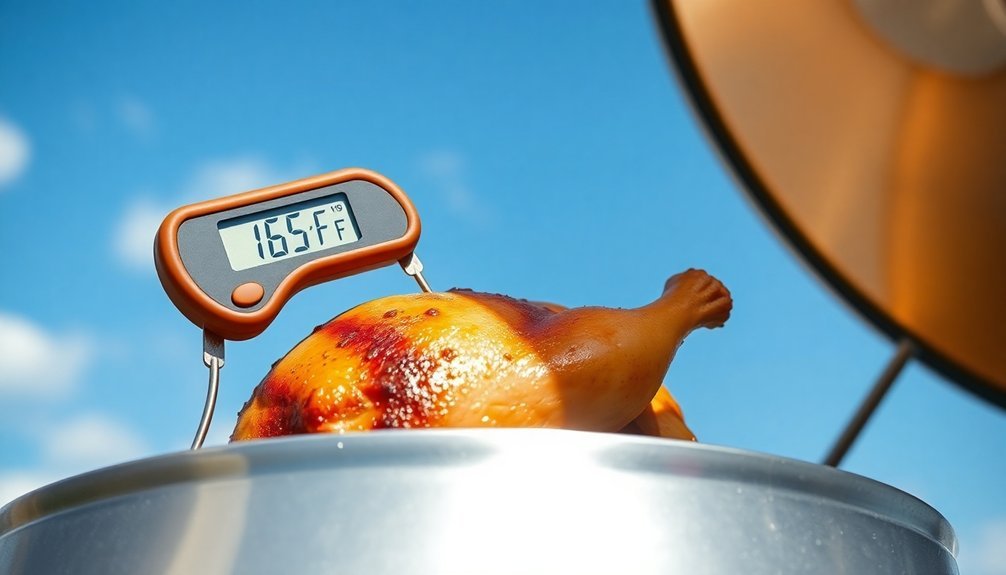
To guarantee your solar-cooked meat reaches a safe internal temperature of 165°F, you'll need to monitor it using a reliable Type-K thermocouple or cooking thermometer inserted into the thickest part of the meat.
You can enhance heat distribution by using dark-colored, lidded cookware and positioning reflective panels around your solar oven to concentrate sunlight onto the cooking surface.
Keep the oven properly aligned with the sun by adjusting its position every 30-45 minutes while maintaining effective insulation around the cooking cavity to prevent heat loss. Surrounding the cooking area with crumpled newspaper insulation helps maintain consistent temperatures needed for safe meat preparation.
Temperature Monitoring Methods
Accurate temperature monitoring forms the backbone of successful solar cooking, especially when preparing meat to a safe internal temperature of 165°F.
You'll need reliable tools like digital probe thermometers and Type-K thermocouples to track your food's internal temperature throughout the cooking process.
Modern monitoring methods combine traditional tools with smart technology to guarantee food safety:
- Use mobile apps to receive real-time temperature alerts on your phone
- Place thermocouples at different points in your solar oven for thorough heat mapping
- Monitor environmental factors like sun position and cloud cover through integrated weather data
When tracking temperatures, maintain proper sensor placement and regular calibration of your monitoring tools.
Set up automated alerts to notify you if temperatures drop below the safe cooking range, ensuring your meat reaches and maintains the critical 165°F threshold.
Heat Distribution Techniques
Mastering heat distribution in solar cooking requires a strategic combination of positioning, thermal mass, and design elements to maintain the essential 165°F temperature.
You'll need to position your solar cooker between 11 AM and 3 PM, adjusting it every 20-30 minutes to track the sun. Place dark-colored thermal mass materials like bricks or granite at the bottom and around your cookware to guarantee even heat distribution.
Use dark metal pots with tight-fitting lids, and surround them with proper insulation. To maximize heat distribution, you'll want to incorporate reflective panels strategically and protect your cooker from wind interference.
The cooker's parabolic design, combined with a gimbal for easy rotation, helps concentrate sunlight effectively. Remember to angle the cooker according to your latitude for best solar radiation capture.
Time and Temperature Relationships
Your solar-cooked meat's internal temperature must reach and maintain 165°F to confirm heat properly penetrates throughout the entire cut.
The length of time needed for complete penetration depends on factors like meat thickness and solar oven temperature, which typically requires double the cooking time of conventional methods.
You'll need to monitor the meat's core temperature with a probe thermometer until it holds steady at 165°F for at least 15 minutes to guarantee food safety.
Heat Penetration Over Time
While solar cooking offers a sustainable way to prepare meals, understanding heat penetration over time is essential for food safety and optimal results.
You'll need to account for how heat gradually moves through your food, which depends on your cooker type and the pot's material. A 4-pound portion typically requires 1-2 hours of cooking on a sunny day.
For maximum heat penetration in solar cooking:
- Use dark, shallow, thin metal pots with tight-fitting lids
- Place food in a clear plastic bag or under an inverted glass bowl to trap heat
- Position your cooker to maximize sunlight exposure throughout cooking time
Don't let your food remain between 125-50°F for more than four hours, as this temperature range can promote bacterial growth.
Remember that factors like seasonality, available sunlight, and wind conditions will affect your cooking duration.
Safe Temperature Duration Required
To guarantee food safety when solar cooking meat, maintaining proper temperature duration is just as essential as reaching the right internal temperature.
You'll need to keep your food out of the danger zone (40°F to 140°F) for all but 2-4 hours of the total cooking time. When solar cooking poultry or ground meats, you must maintain 165°F for a sustained period to kill harmful bacteria.
You'll want to plan your cooking between 11 AM and 3 PM when the sun's strongest, and remember that solar cooking typically takes twice as long as conventional methods.
Use your thermometer frequently to verify temperatures, and if you can't maintain safe heat levels, switch to an alternative cooking method.
Don't rely on color or texture alone – temperature duration is your key to food safety.
Safe Internal Temperature Guidelines
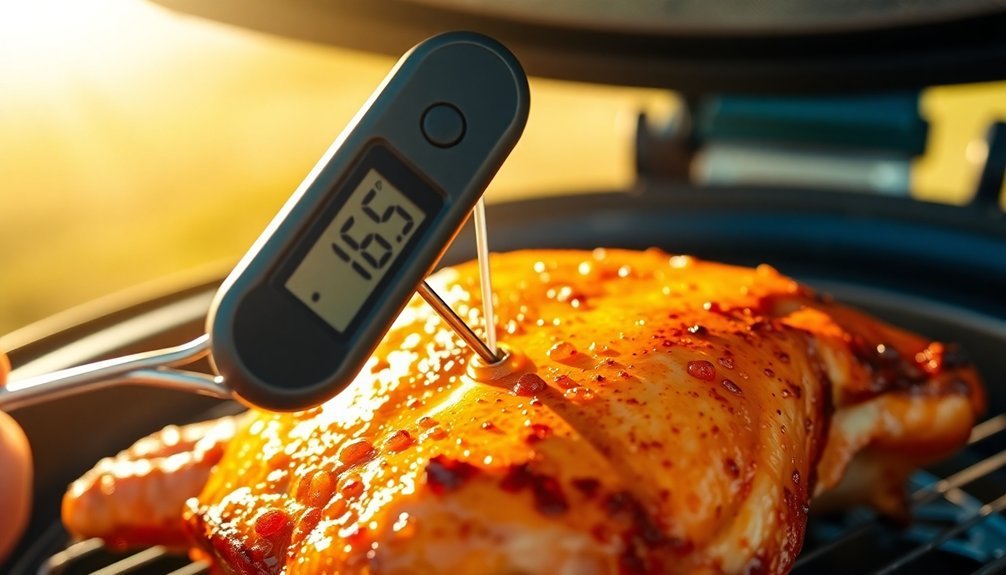
Understanding safe internal temperatures is essential for successfully cooking meat in a solar oven. You'll need to follow specific temperature guidelines based on the type of meat you're cooking.
While whole cuts of beef, pork, lamb, and veal require a minimum of 145°F with a three-minute rest period, ground meats must reach 160°F due to their increased risk of contamination during processing.
- Picture steam rising from a perfectly cooked chicken breast that's reached the required 165°F
- Imagine a burger patty with clear juices running out after hitting 160°F
- Visualize a beef roast resting for three minutes after reaching 145°F
All poultry must reach 165°F regardless of whether it's whole or ground.
When using your solar oven, you'll want to monitor these temperatures carefully, as indirect heat may require longer cooking times.
Proper Meat Temperature Testing
Proper meat temperature testing requires three essential elements: the right thermometer, correct placement technique, and consistent monitoring.
You'll need to insert your thermometer probe through the thickest part of the meat until it hits bone, then slowly pull it back to find the lowest temperature reading. This indicates the center's true temperature. Don't let the probe touch fat, bone, or gristle, as these can give false readings.
For accurate results, choose your thermometer based on your cooking method. Oven-safe models can stay in while cooking, while digital instant-reads work best for quick checks.
When using a solar oven, you'll need to monitor temperatures continuously and adjust the oven's position every 1-2 hours to follow the sun.
Keep your thermometer clean and calibrated to guarantee reliable readings.
Weather Impact on Cooking
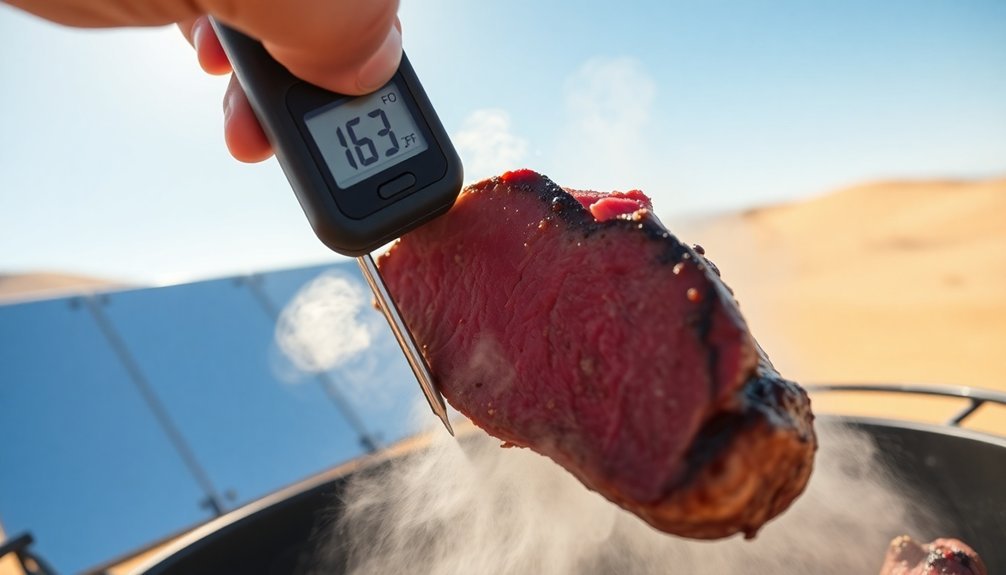
When cooking with a solar oven, weather conditions play a crucial role in reaching and maintaining the required 165°F internal meat temperature. You'll need to monitor cloud cover, wind, and seasonal changes as they directly affect your cooking success.
Peak cooking hours between 11:00 am and 3:00 pm offer the best conditions for achieving safe meat temperatures.
For ideal results in varying weather conditions:
- Position your oven in a wind-protected spot to maintain consistent internal temperatures
- Track the sun's movement and adjust your oven's angle, especially during winter months
- Use heat-retention features and proper insulation to combat cloudy days
During less-than-ideal weather, expect longer cooking times and plan accordingly.
Winter cooking requires extra attention due to shorter days and lower sun angles, while summer offers more flexibility for reaching safe meat temperatures.
Best Solar Cooking Practices
Beyond mastering weather conditions, successful solar cooking relies on proven techniques to achieve safe meat temperatures.
You'll need to preheat your solar oven for 15-20 minutes and position it facing south for maximum sun exposure. Use dark-colored cookware or cover light containers with a dark towel to improve heat absorption.
To maintain food safety, monitor the internal temperature with a thermometer until it reaches 165°F. Keep your food sealed with clear plastic wrap to create a greenhouse effect and retain heat.
Add insulation like crumpled newspapers around the cooking chamber, and adjust the reflector flaps to concentrate sunlight effectively. Remember to handle hot cookware with oven mitts and guarantee your raw meat stays cold until you're ready to cook.
Record cooking times and temperatures to improve your future solar cooking sessions.
Frequently Asked Questions
Can I Safely Cook Frozen Meat Directly in a Solar Oven?
Yes, you can cook frozen meat directly in your solar oven. Just place it in early morning and guarantee it reaches safe internal temperatures: 145°F for whole cuts, 160°F for ground meat, and 165°F for poultry.
What Happens if Clouds Appear During the Final Cooking Phase?
If clouds appear during final cooking, you'll need to monitor your food's temperature closely. You should have a backup heat source ready, as dropping temperatures can put your food in the unsafe zone.
Does Marinating Meat Affect the Required Internal Cooking Temperature?
No, marinating your meat doesn't change the required internal temperature. You'll still need to cook it to 165°F for safety, as marinades only enhance flavor and tenderness but don't kill harmful bacteria.
Can Different Types of Meat Be Cooked Together Safely?
You can cook different meats together, but you'll need to guarantee all pieces reach their respective safe temperatures. It's best to separate poultry from other meats since chicken requires a higher internal temperature.
How Long Can Solar-Cooked Meat Stay Warm in the Oven?
You shouldn't leave your solar-cooked meat in the oven for more than two hours at room temperature, or one hour on hot days. If you can't maintain 125°F, cool it below 50°F quickly.
In Summary
You'll need to guarantee your solar-cooked meat reaches 165°F to kill harmful bacteria like Salmonella and E. coli. Don't rely on appearance alone, as these pathogens can survive at lower temperatures. Always use a meat thermometer to verify the internal temperature, and remember that weather conditions can affect your solar cooker's performance. When in doubt, it's better to cook longer than risk foodborne illness.
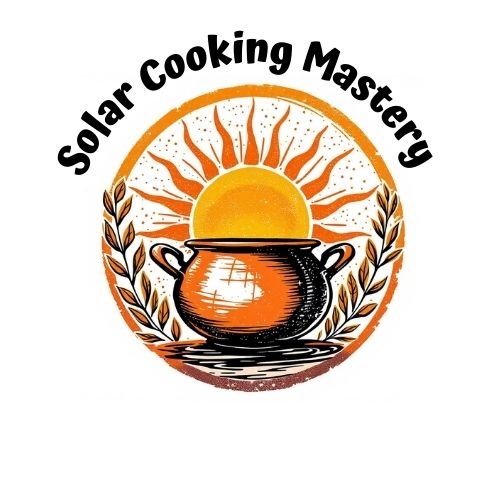
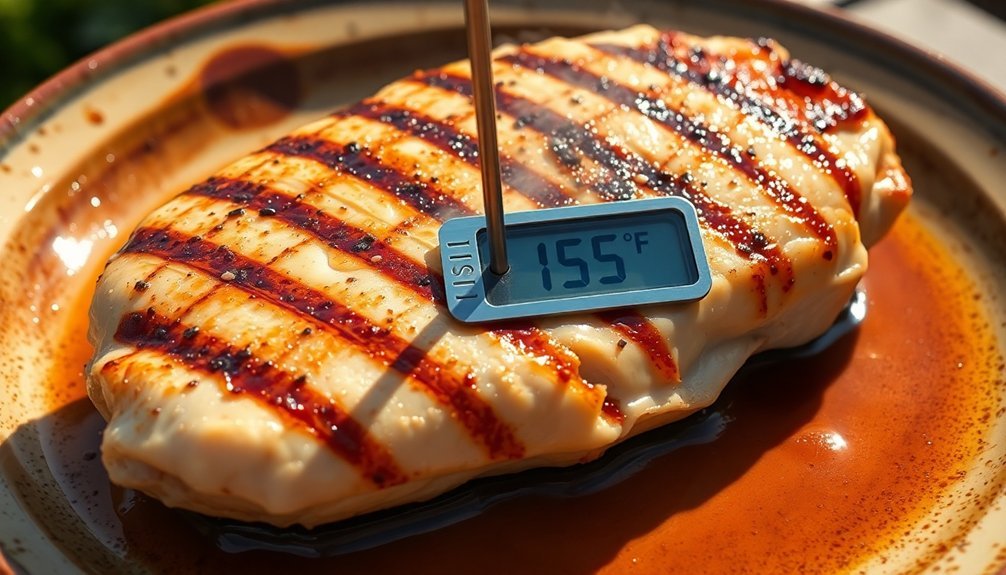
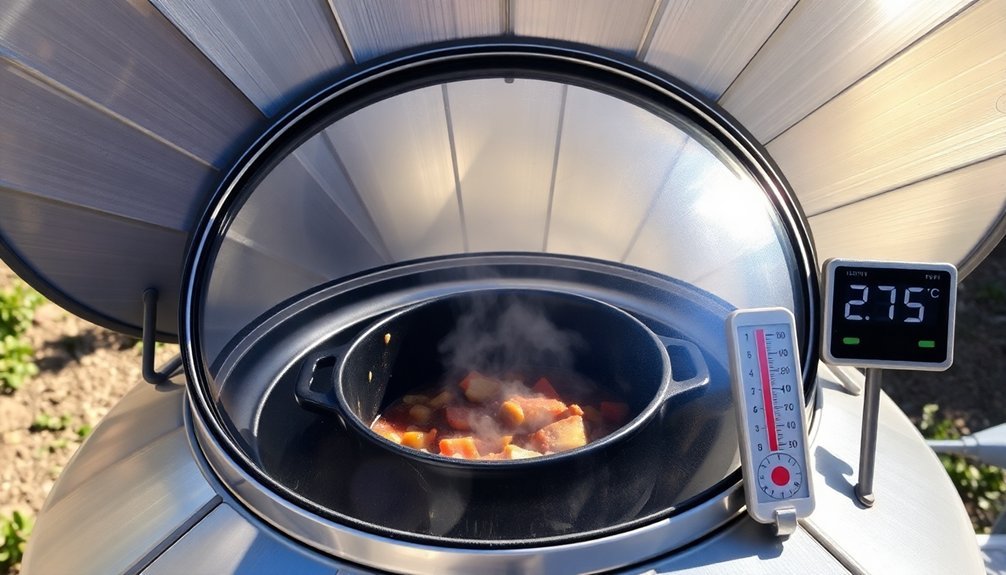


Leave a Reply